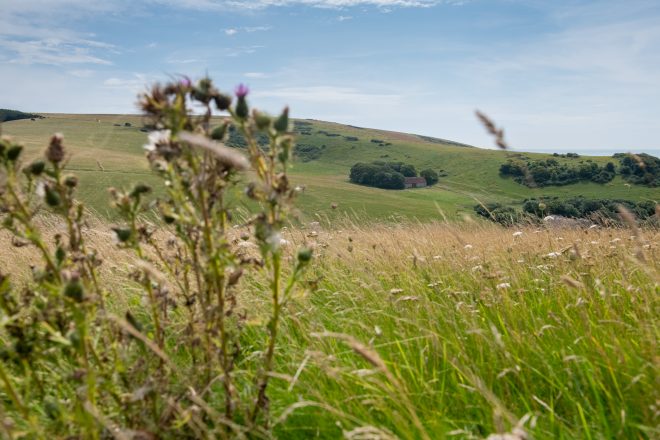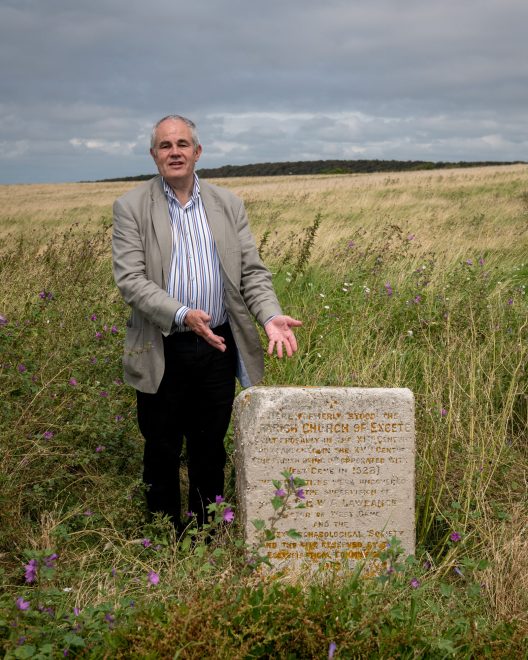South Downs History Special: The Lost Village of Exceat
November 3, 2023

Perched on a blustery hill overlooking Cuckmere Haven was a village said to be a strategic naval base for King Alfred The Great, who is widely recognised as the first king of England.
 But, by the mid-1400s, this once bustling village was abandoned – the remains of its buildings and church disintegrated and entombed in the landscape for hundreds of years until a local boy observed the outline of a building in a dry field, leading to archaeological excavation in 1913 that revealed the foundations of Exceat Church.
But, by the mid-1400s, this once bustling village was abandoned – the remains of its buildings and church disintegrated and entombed in the landscape for hundreds of years until a local boy observed the outline of a building in a dry field, leading to archaeological excavation in 1913 that revealed the foundations of Exceat Church.
What did happen to the lost village of Exceat? Anooshka Rawden, Cultural Heritage Lead for the National Park, has been looking at the rise and fall of the settlement that arguably had one of the most beautiful views in England.
Exceat was a fishing village founded in Saxon times and the name may have come from “æc-sceat”, an oak grove, or from the Old English for “the place of the Aese”, who were the first kings of Kent. King Alfred the Great (b: 849 d: 899) was thought to have had a palace at nearby West Dean, and some historians have suggested that Exceat may have served as one of his main naval bases in his wars against the Danish.
The settlement was listed in the Domesday Book of 1086 as Essete, in Sussex. Rectors for its church dated from 1255 when a pipe-roll mentions “Richard, the Parson at Excete” (A pipe-roll is a record of the annual audit by the Exchequer).
After several centuries as an important village in a prominent coastal location, all was to change by the 1300s. A series of major catastrophic events, most notably the Black Death, were to wreak havoc on its small rural population.
The Black Death came to England in around 1347/1348. The term ‘Black Death’ is not actually medieval, but a 17th century title for what was the most severe pandemics in our history – bubonic plague. It created fear and recrimination, and led to significant social and economic upheaval. It spread across modern day Europe, Asia, North African and the Middle East, a global catastrophe felt by every family, every community.
Estimates have suggested that between 40% and 60% of England’s population died. Another wave of the plague came back in the 1460s, killing off an estimated additional 20% of the population. Plague continued to break out in England throughout the medieval period and into the 18th century.
 One crucial thing to remember is how chaotic the 14th century would have been for people living in and around Exceat – it was a century of crisis. The plague was one of a number of impacts to the population, which included a so-called “Little Ice Age” that hit agricultural communities hard and contributed to the Great Famine of 1315-1317; a cattle disease killed livestock across England between around 1319-1321, followed by war between England and France from 1337 – the so-called Hundred Years War that saw raids across coastal England.
One crucial thing to remember is how chaotic the 14th century would have been for people living in and around Exceat – it was a century of crisis. The plague was one of a number of impacts to the population, which included a so-called “Little Ice Age” that hit agricultural communities hard and contributed to the Great Famine of 1315-1317; a cattle disease killed livestock across England between around 1319-1321, followed by war between England and France from 1337 – the so-called Hundred Years War that saw raids across coastal England.
So, before the Black Death, life was already tough, despite the century beginning with an agricultural boom. It’s no wonder by the time plague came, people equated it to the end of days – suddenly a people who lived with the harshest realities of death far more closely than we do today were living in absolute fear of it, as the plague killed so indiscriminately and quickly.
The village may also have fallen victim to the Hundred Years War with France. Numerous French and Castilian raids were made along the Sussex coast in the 1370s and 1380s and Exceat’s location left it vulnerable. Depopulation and decline had irreversibly set in, and by 1460 only two parishioners are recorded as still living at Exceat: Richard Raye and John Algar.
They petitioned the Bishop of Chichester to join the congregation of West Dean and, in 1528, the parish of Exceat merged with West Dean.
Fast forward to a hot summer’s day in 1913, just a year before the outbreak of the First World War. A teenager walking on the hills spotted some indentations in the fields above the Cuckmere River.
Maurice Theodore Lawrance, the 15-year-old son of the rector of West Dean Church, told his father, The Reverend George William Lawrance, and, with the help a local antiquarian Mr RH Verrall, some stone foundations were discovered. Permission was later granted for Sussex Archaeological Society to excavate the site and the building they eventually found was Exceat Church. The excavations revealed a tiny church, probably among the smallest in Sussex with a nave only 31 feet. In the centre of the nave was a single burial and this was probably the grave of a former rector.
If you visit Seven Sisters Country Park today, in amongst the chalk grassland, you’ll find a large Portland stone block with the graving “Here formerly stood the Parish Church of Excete”.
Today Exceat is one of a number of “ghost villages” (known as Deserted Medieval Villages) in Britain and, while we can make educated explanations about its fate, one feels there’s still so much to be learnt about this fascinating windswept site high up on the hilltop.
It also stands as a testament to an observant local boy, who discovered the stories of a community lost to time – three years after his discovery, Maurice Theodore Lawrance tragically died aged 18, having been killed in action in France during the First World War.
He has no known grave. Like many Sussex men who never came home from this conflict, communities remember – he is commemorated at All Saints Church, West Dean. Find the site of the village on the Country Park Trail route on this map of Seven Sisters Country Park.

